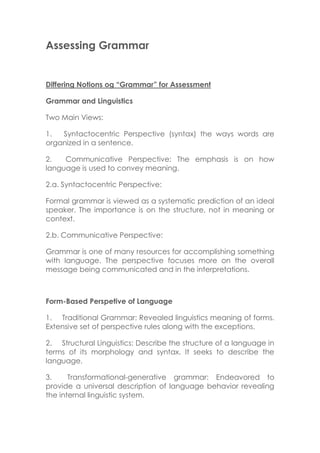Texts Summary
•Télécharger en tant que DOCX, PDF•
0 j'aime•741 vues
Signaler
Partager
Signaler
Partager

Recommandé
Recommandé
Contenu connexe
Tendances
Tendances (20)
Language Programs and Policies in Multilingual Societies.pptx

Language Programs and Policies in Multilingual Societies.pptx
Different Levels of Stylistics Analysis 1.Phonological level 2.Graphologic...

Different Levels of Stylistics Analysis 1.Phonological level 2.Graphologic...
Principles and Theories of Language Acquisition and Learning

Principles and Theories of Language Acquisition and Learning
Similaire à Texts Summary
Similaire à Texts Summary (20)
Plus de Jano Avila Moncada
Plus de Jano Avila Moncada (19)
Dernier
Dernier (20)
How to Troubleshoot Apps for the Modern Connected Worker

How to Troubleshoot Apps for the Modern Connected Worker
TrustArc Webinar - Unlock the Power of AI-Driven Data Discovery

TrustArc Webinar - Unlock the Power of AI-Driven Data Discovery
A Beginners Guide to Building a RAG App Using Open Source Milvus

A Beginners Guide to Building a RAG App Using Open Source Milvus
Web Form Automation for Bonterra Impact Management (fka Social Solutions Apri...

Web Form Automation for Bonterra Impact Management (fka Social Solutions Apri...
ProductAnonymous-April2024-WinProductDiscovery-MelissaKlemke

ProductAnonymous-April2024-WinProductDiscovery-MelissaKlemke
Axa Assurance Maroc - Insurer Innovation Award 2024

Axa Assurance Maroc - Insurer Innovation Award 2024
Apidays Singapore 2024 - Scalable LLM APIs for AI and Generative AI Applicati...

Apidays Singapore 2024 - Scalable LLM APIs for AI and Generative AI Applicati...
Cloud Frontiers: A Deep Dive into Serverless Spatial Data and FME

Cloud Frontiers: A Deep Dive into Serverless Spatial Data and FME
Why Teams call analytics are critical to your entire business

Why Teams call analytics are critical to your entire business
Polkadot JAM Slides - Token2049 - By Dr. Gavin Wood

Polkadot JAM Slides - Token2049 - By Dr. Gavin Wood
Apidays New York 2024 - Scaling API-first by Ian Reasor and Radu Cotescu, Adobe

Apidays New York 2024 - Scaling API-first by Ian Reasor and Radu Cotescu, Adobe
EMPOWERMENT TECHNOLOGY GRADE 11 QUARTER 2 REVIEWER

EMPOWERMENT TECHNOLOGY GRADE 11 QUARTER 2 REVIEWER
ICT role in 21st century education and its challenges

ICT role in 21st century education and its challenges
Repurposing LNG terminals for Hydrogen Ammonia: Feasibility and Cost Saving

Repurposing LNG terminals for Hydrogen Ammonia: Feasibility and Cost Saving
Automating Google Workspace (GWS) & more with Apps Script

Automating Google Workspace (GWS) & more with Apps Script
Texts Summary
- 1. Assessing Grammar Differing Notions og “Grammar” for Assessment Grammar and Linguistics Two Main Views: 1. Syntactocentric Perspective (syntax) the ways words are organized in a sentence. 2. Communicative Perspective: The emphasis is on how language is used to convey meaning. 2.a. Syntactocentric Perspective: Formal grammar is viewed as a systematic prediction of an ideal speaker. The importance is on the structure, not in meaning or context. 2.b. Communicative Perspective: Grammar is one of many resources for accomplishing something with language. The perspective focuses more on the overall message being communicated and in the interpretations. Form-Based Perspetive of Language 1. Traditional Grammar: Revealed linguistics meaning of forms. Extensive set of perspective rules along with the exceptions. 2. Structural Linguistics: Describe the structure of a language in terms of its morphology and syntax. It seeks to describe the language. 3. Transformational-generative grammar: Endeavored to provide a universal description of language behavior revealing the internal linguistic system.
- 2. According to Chomsky’s UG (Universal Grammar), language consist of the universal principles and the language-specific rules. There are some other aspects that need to be understood. Syntax and Morphology on their own are not enough to understand a language. Assessing grammar is a high influenced by sytactocentric approach , but those theories have to deal with meaningfulness appropriateness, acceptability and naturalness. Form-and-Use-Based Perspectives of Language If we would like the main differences between similar structures we would need all those theories to understand it. A focus on grammatical form alone may not be enough in L2 to determine if learners have sufficiently acquired a structure to communicate effectively. What’s Pedagogical Grammar? The importance of the words will vary, it will always depend on the classroom context. Assessing Vocabulary MEASURING VOCABULARY SIZE Vocabulary size is related to Reading comprehension, that’s why vocabulary tests are quite relevant research on reading development and literacy programs.
- 3. -Sampling from word frequency lists · Dictionaries do not show how frequent a word is. The preferred lexical unit is the world family, which consist of a base word and its inflected and derived forms. Vocabulary tests focuses on a lower range of words for non-native speakers than for native speakers. · GSL: Selection of 2000 high-frequency word families. · AWL (Academic Word List): Set of 570 word families. It has been very influential in the recent years in the teaching and testing of English for academic purposes. · Ward states that AWL is not the useful or frequent for every type of learner. · AWL is not very frequent in Sciences, Engineering and Social Sciences. There is no definite frequency list. -The Yes/No Format · Developing Size Vocabulary Test: select a sample of target words. · The simplest test formats are called checklists; yes/no tests. · The presentation of the vocabulary may affect the test taker. The written form will always be the same, whereas oral language will vary according to the speaker accent, linguistic context, intention, etc. · There are well-established procedures for measuring the size of learners’ vocabulary. It is difficult to find the perfect word frequency list. · Despite its simplicity, yes/no format has proved to be and informative and cost-effective means of assessing the state of learners vocabulary knowledge.
- 4. -Testing Depth of Knowledge. · There is less progress in measuring quality of vocabulary knowledge; about use, frequency, functional, etc. · There is no depth measure that has reached the same wide acceptance than Vocabulary Levels Test in vocabulary size.
